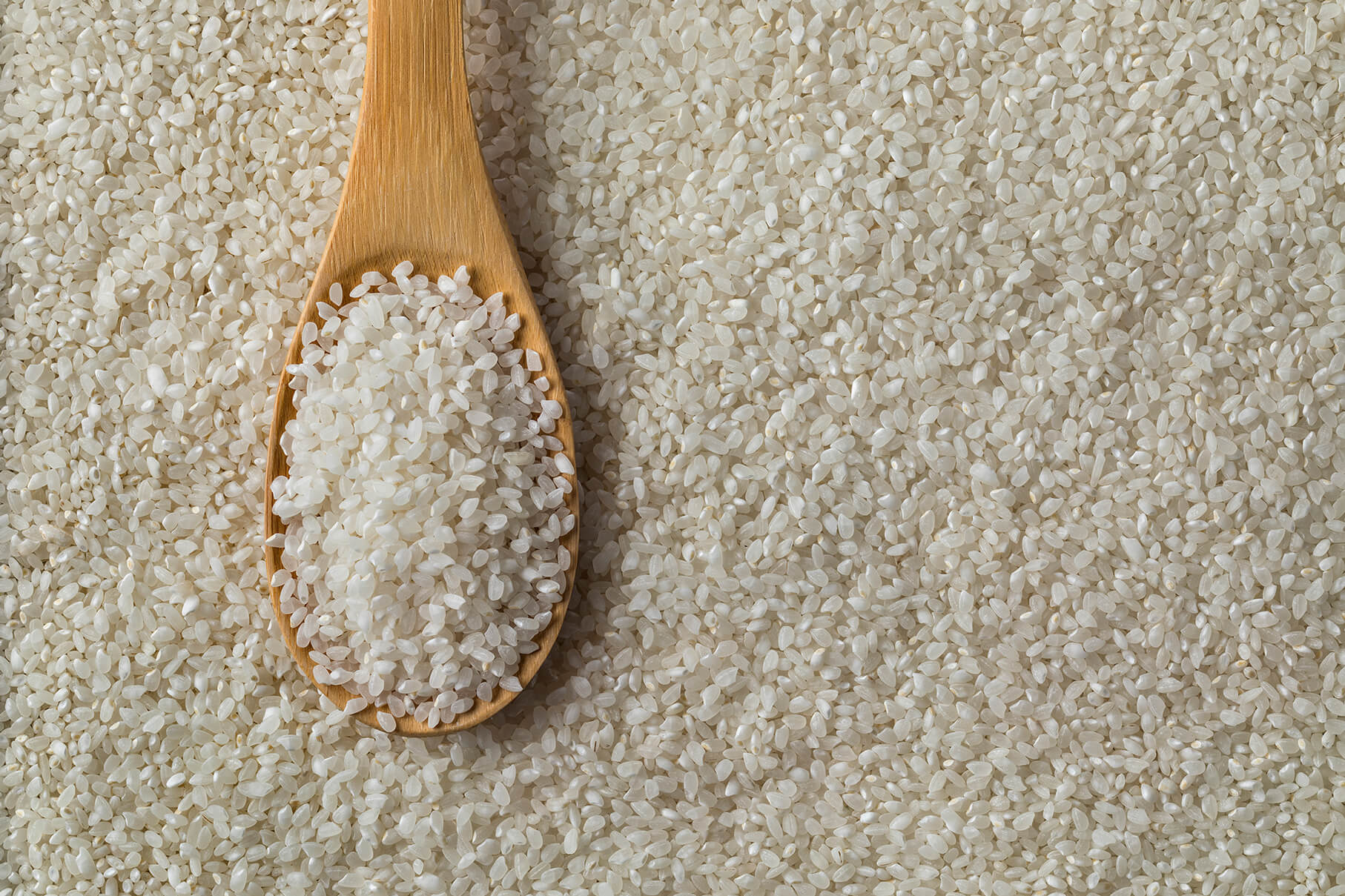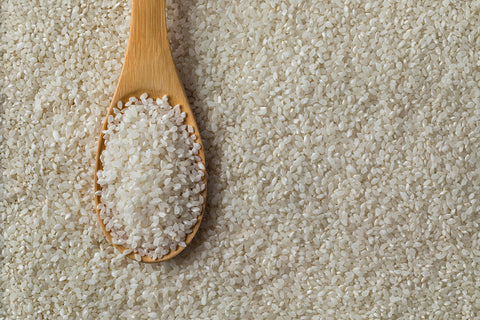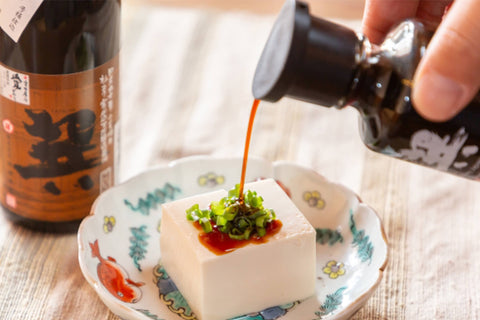
Rice is a staple ingredient in many East Asian diets, including Chinese, Korean, Mongolian, Thai and, of course Japanese cuisine. It is a primary source of carbohydrates for this region, as rice can be cultivated in rocky and mountainous terrain with a shortage of arable land and nitrous-rich soil.
Types of Japanese Rice
The term Japanese rice refers specifically to several species of Japonica rice, which are normally separated into two categories – uruchimai and mochigome.

Uruchimai
Uruchimai consists of short translucent grains and is what we would consider regular Japanese rice. Once cooked, it has a sticky texture that allows it to be easily picked up and eaten using chopsticks. This stickiness is what makes uruchimai perfect for sushi and, indeed, it is often labelled as sushi rice outside of Japan. Uruchimai is also the principle type of Japanese rice used in the production of sake.

Mochigome
Mochigome is a glutinous rice used for speciality dishes such as mochi, okowa, and sekihan, among others. It is a short-grain variety of rice, easily-distinguished from uruchimai by its short, round, and opaque grains. When cooked, mochigome also has a stickier consistency, along with a firmer, chewier texture.
Varieties of Japanese Rice
Both types of Japanese rice include a wide range of varieties, or cultivars. Often the only difference between them is the part of the country in which they are grown, though some cultivars do have specific properties that are unique to them.
Koshihikari: a well-respected cultivar in Japan and one of the most commonly grown in the country.
Akitakomachi: another popular and esteemed cultivar
Sasanishiki: this cultivar is well-known for retaining the same flavour when cooled down as it has when cooked
Yamada Nishiki: this is one of several cultivars grown specifically for producing sake, and by far the most famous of them
Oborozuki and Yumepirika: these cultivars were developed in Hokkaido, specifically to withstand the cold climate in that part of Japan
Calrose
Calrose is a specific cultivar of Japanese rice grown exclusively outside of Japan. As the name suggests, this particular species is grown in California, principally by Japanese Americans. This medium-grain rice was developed in 1948 and is a common ingredient in Japanese cuisine across North America. Whilst it makes for a reasonable sushi rice, it has failed to gain much in the way of popularity back in Japan.Processing
Both uruchimai and mochigome begin as brown rice, which is often polished by a machine and sold as white rice. While brown rice is occasionally consumed unpolished, this is normally for specific health benefits and is considered something of a speciality.
A common sight in rural Japan is the coin-operated rich polishing machine, known as seimaijo, which typically polish 10kg of brown rice for the price of 100 yen. The polishing process produces a by-product known as rice bran, or komenuka. In commercial quantities, it is used to make rice bran oil, which is notable both for its high smoke point (making it useful for high temperature cooking) and its numerous health benefits. Rice bran oil is known to reduce blood sugar levels, blood pressure, and cholesterol. It is also used in Japanese cuisine for making a particular kind of pickle, known as nukazuke
Another popular type of Japanese rice is musenmai. This is white rice that has been processed further to remove an additional sticky coating from the grain. This is normally removed by soaking the rice prior to cooking, which is why musenmai is also known as no-wash rice.Uses of Japanese Rice
Japanese rice, particularly uruchimai, is a staple ingredient in Japanese cooking. Indeed, there are few meals that do not incorporate rice in some way. It is most commonly consumed as a plain rice dish known as gohan (cooked rice), either on its own, or accompanied by several other dishes. These can include a wide variety of side dishes (okazu), various pickles (tsukemono), brined or fermented fruits (umeboshi), and miso soup. Plain uruchimai can also be served with a range of toppings such as furikake, used to add flavour and texture to the dish.

Japanese rice forms the core of a Japanese breakfast, where it is often mixed with raw egg and soy sauce to produce tamago kake gohan. Plain Japanese rice is also used in a range of Western-inspired dishes, known as yōshoku dishes such as curry rice and omelette rice (omurice). Leftover plain rice is often reused and reheated in dishes like ochazuke (rice with green tea) and chāhan (fried rice), as well as many others.
 Uruchimai is also used in the production of various alcoholic drinks. It is brewed to make sake, distilled to make shōchū, and used as the grain base for malting Japanese beer. Uruchimai can also be fermented and distilled to produce rice vinegar.
Uruchimai is also used in the production of various alcoholic drinks. It is brewed to make sake, distilled to make shōchū, and used as the grain base for malting Japanese beer. Uruchimai can also be fermented and distilled to produce rice vinegar. Raw, unprocessed grains of brown rice are used in the brewing of brown rice tea (genmaicha). The grains are roasted and popped before being mixed with green tea leaves and left to brew in boiling water. This tea has a mild, yet distinctive flavour and a powerful aroma from the roasted rice grains.
Raw, unprocessed grains of brown rice are used in the brewing of brown rice tea (genmaicha). The grains are roasted and popped before being mixed with green tea leaves and left to brew in boiling water. This tea has a mild, yet distinctive flavour and a powerful aroma from the roasted rice grains. Mochigome, is used for making mochi, a sweet snack popular across Japan. Mixed with water, sugar, and cornstarch, the resultant paste can be moulded into a variety of shapes. The glutinous rice us also used to make sekihan, being mixed and cooked with red azuki beans to make this festive favourite dish.
Mochigome, is used for making mochi, a sweet snack popular across Japan. Mixed with water, sugar, and cornstarch, the resultant paste can be moulded into a variety of shapes. The glutinous rice us also used to make sekihan, being mixed and cooked with red azuki beans to make this festive favourite dish.
Preparation
Most Japanese people use a rice cooker (or suihanki), into which they add carefully measured amounts of rice and water. Before cooking, the rice is washed in order to release any excess starch and usually soaked in water for anywhere between 30 minutes and two hours, depending on the time of year and the quality of the rice. The rice boiled and then steamed until the centre of the rice grains are soft. Rice prepared in this manner is usually served direct from the rice cooker into a rice bowl, or chawan. Alternatively, it can be placed into an ohitsu, a covered wooden box that retains the steam from the rice, keeping it moist until ready for service.Popular Products
These are just some of the Japanese rice products and variations that prove particularly popular at SushiSushi. Click on a link to learn more, or visit our online store for more Japanese rice products.
Okuizumo Nitamai Rice
This premium rice is cultivated with no chemical fertilisers, relying instead on organic wagyu fertiliser for nutrients and snow water for hydration. This imparts high levels of natural minerals to the rice, improving its quality. Perfect for rice balls and bento boxes.
Yamazaki Emi No Kizuna Sushi Rice
Rich and glutinous, emi no kizuna rice is cultivated specifically for use in sushi recipes. Similar in texture and appearance to koshi-hikari Japanese rice, it allows both new and experienced chefs to create all manner of sushi dishes of the highest quality.
Otsuka Miora Rice Improver
Miora rice improver contains a proteolytic enzyme that increases the absorptive properties of the rice grains. This produces moist, shiny rice that will not stick to the pan. Used with a quality rice cooker, you are guaranteed excellent sushi rice every time.
Mitake Rice Flour
Rice flour is a popular, gluten-free alternative to wheat flour in all kinds of recipes, as well as being used to thicken soups, stews, and sauces, much like cornflour. In Japanese cuisine it is used for making rice noodles and tempura batter.
Our Suppliers
Here at SushiSushi, we source our Japanese rice from some of the most well-respected and established producers in Japan. These include:
Agri Yamazaki
At their immense rice farm in Ibaraki, Agri Yamazaki produces Japanese rice of the highest quality. Their main cultivars are koshihikari and Milky Queen, a recent cultivar that is fluffy, sweet, and sticky – perfect for sushi.

Okuizumo Nitamai Rice Company
The Okuizumo Nitamai Rice Company grows its Japanese rice on traditional rice terraces at their paddy fields in Nita-gun. Set at an altitude of 300-500m these terraces benefit from high temperatures during the day and low temperatures during the night, which lead to high starch contents and more flavourful rice.











